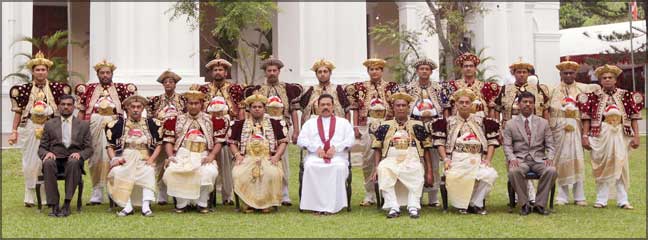|
Let’s heal the wounds of the world The
Buddha’s message for the next century
P.D. Areyaratne.
To
keep the Dhamma alive through the coming generations, it
is most essential to find ways to make the teaching
meaningful to the younger generation. Given the way
Buddhism in Sri Lanka exists today, it seems to me that
an educated young person will see in it little more than
a system of rites and rituals, useful perhaps as a
reminder of one’s ancient cultural and ethnic identity,
but with very little relevance to their present
concerns. The youth are the ones who will have to see
that Buddhism serves the next century and that it will
be able to offer its rich insights and spiritual
practices to the global community.
When we look at the way of life gaining ascendency in
this country today, it seems that the true Dhamma is
rapidly losing its influence. There are plenty of
temples; gigantic Buddha images looking out on us from
the hills and roadways, and “Pirith” chanting is
broadcast daily in all the major towns.
But life inspired and guided by the Dhamma, based on
moral rectitude, on loving kindness and compassion, on
respect and care for others, is on the decline.
To prevent the Dhamma from disappearing, radical and
far-sighted steps will have to be taken, and I believe
the main responsibility for this falls on the Sangha. If
the Sangha has the insight and courage needed to take
the steps required, the sasana can recover its strength.
If it does not act boldly, with wisdom and courage, the
decline is likely to continue.
It is futile, to keep on harping back to the injustices
committed against Buddhism during the colonial period,
or to indulge in the fantasy that the rest of the world
is involved in a conspiracy to undermine the Sasana.
Most of the measures recommended by the Buddhist
Commission in the late 1950s have been implemented, and
today Buddhism enjoys a favoured place in the life of
the nation.
To keep the Dhamma alive through the coming generations,
it is most essential to find ways to make the teaching
meaningful to the younger generation. Given the way
Buddhism in Sri Lanka exists today, it seems to me that
an educated young person will see in it little more than
a system of rites and rituals, useful perhaps as a
reminder of one’s ancient cultural and ethnic identity,
but with very little relevance to their present
concerns. The youth are the ones who will have to see
that Buddhism serves the next century and that it will
be able to offer its rich insights and spiritual
practices to the global community.
Success in keeping Buddhism alive will require that the
true spiritual essence of the Dhamma be extracted from
its often constricting institutional embodiments. Above
all, this task demands that the Dhamma be treated not as
a basis for ethnic identity or cultural pride but as a
living path of spiritual development and personal
transformation that touches our most fundamental
attitudes, goals, and values. It is only where the
Dhamma is appropriated in such a way that it will serve
to heal the wounds in our own minds and hearts the deep
hidden wounds of greed, hatred, and delusion. And it is
only by healing the wounds within, that we can face the
momentous task of helping to heal the wounds of the
world.
Kandy’s glamour

President Mahinda Rajapaksa with Diyawadana Nilame
Pradeep Nilanga Dela and other Nilames from the four
Devalas at Kandy Janadhipathi Mandiraya after the
successful completion of the Dalada Perahera. Pictures
by Sudath Silva
|